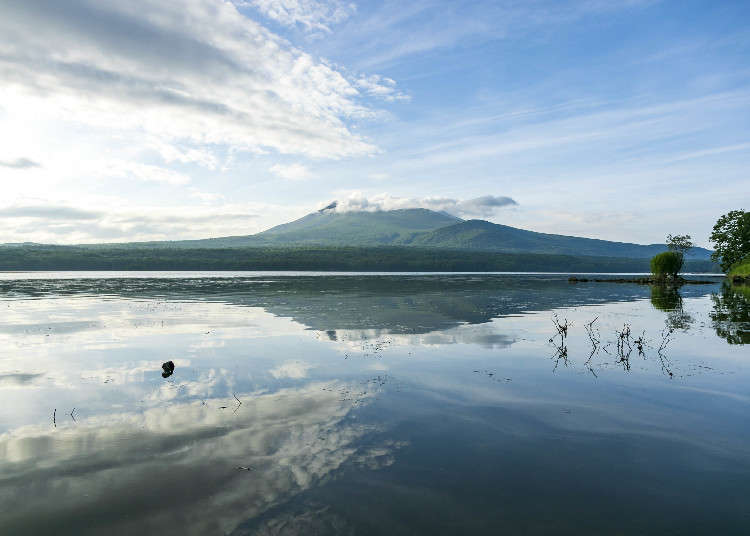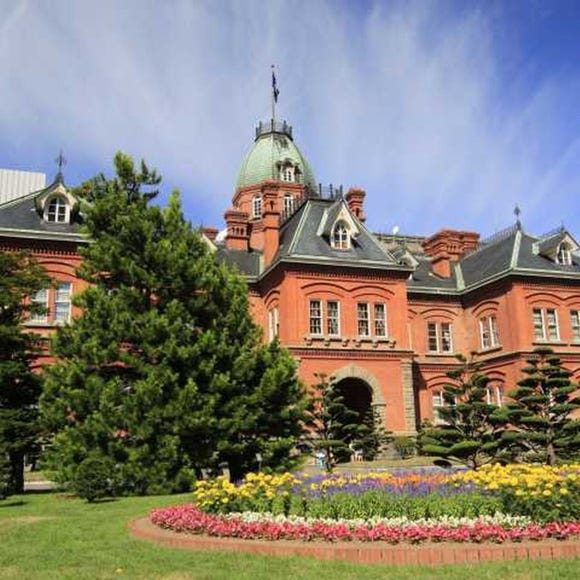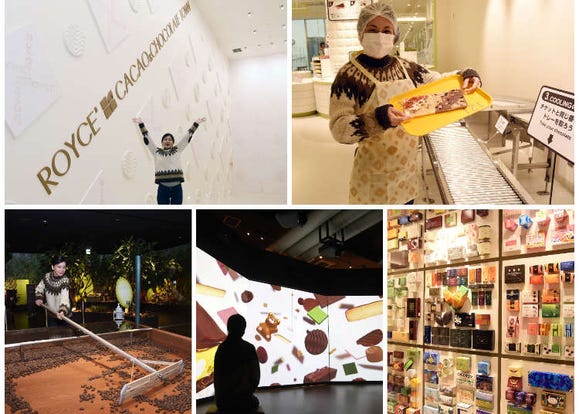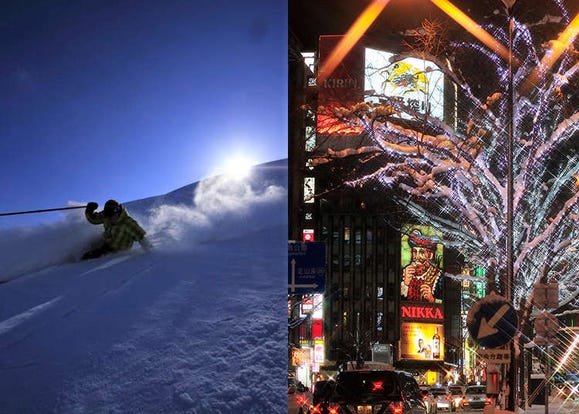
大沼國定公園位於北海道函館市北方約30公里之處,1903年經過整頓,現為日本歴史悠久的自然公園之一。包括美麗的活火山、北海道駒岳(駒ヶ岳)、以及因火山噴發形成的3個湖與周邊一帶。大沼國定公園廣闊的園内有許多雄偉的天然景觀、親近大自然的野外活動體驗,這次由住在北海道的筆者,帶大家一探究竟,看看當地有那些迷人魅力吧!
大沼國定公園是什麼樣的地方呢?

大沼國定公園橫跨七飯町、鹿部町、森町3個地方,總面積為9,083公頃,是一個占地廣大的自然公園。約3〜5萬年前,北海道駒岳(以下稱駒岳)火山噴發後,大沼原型形成,隨著後續的噴發,出現了大沼、小沼、蓴菜沼共3個堰塞湖。複雜的湖岸線,以及同樣因火山活動造就的眾多島嶼,猶如日本庭園般的視覺享受。這裡也是天鵝等候鳥的遷徙地,在2012年被列為拉姆薩公約的保育濕地。
大沼周邊自江戶時代起就是個知名風景區,1879年德國海因里希親皇、1881年明治天皇均曾留下來訪記錄。1922年成為道立公園,到1958年指定為國定公園,大沼還被國家指定為國際交流據點,具有向世界各國介紹自然、文化、歷史、產業的作用,經常策劃各種參與性和實踐性的旅遊活動,非常活躍。
大沼國定公園交通方式
從函館市中心出發
【開車】
約40分鐘(經由國道5號)
※函館機場出發約30分鐘
【公共交通工具】
JR:特急北斗約25分鐘、普通列車約45分鐘,至「大沼公園」站下車
巴士:函館站前搭乘函館巴士「經大沼公園往鹿部」,車程約70分鐘,至大沼公園下車
從札幌出發
【開車】
札幌市内出發約3小時30分鐘(經由道央自動車道到大沼公園IC、接國道5號)
【公共交通工具】
JR:特急北斗約3小時20分鐘,至「大沼公園」站下車
大沼國定公園觀光重點
島嶼巡遊

大沼3湖上共有126座大大小小的島,其中幾個島上架了橋,方便遊客散步巡島。從公園廣場走過右手邊的西大島橋,連著另外2座島的路線稱為「大島之路(大島の路)」(所需時間約15分鐘),以及從公園廣場走過左手邊的後樂橋,連著7座島的路線稱為「巡島之路(島巡りの路)」(所需時間約50分鐘),兩種主要散步路線。

用充滿日式風情的拱橋(太鼓橋)連結數個小島而成的「巡島之路」,5月步道上有蝦夷杜鵑花(エゾヤマツツジ)、7〜8月湖面上有睡蓮(スイレン)與萍蓬草(コウホネ)盛開,秋季則有絕美紅葉。
大沼&小沼搭乘遊覽船

水上也能感受大沼國定公園的魅力!我們坐上了環島遊覽船,30分鐘的時間周遊大沼湖和小沼湖~

先到廣場右手邊的售票處購票,5月1日〜10月31日定期運航期間,每天9:00〜16:20每隔40分鐘就有一班船,而4月跟11月為不定期運航,開船時間需至售票處確認。

售票處旁有一個小小的伴手禮區,販售如原創濾掛式咖啡(1個220日圓)等搭船的紀念品。

遊覽船本身有屋頂,雨天也能安心搭乘,出航後,船長會一一介紹沿途風景(僅日文),遊覽船接連穿過小島,往大沼湖的中央邁進。

有時可走到遊覽船後方的甲板上眺望外面景色,可惜這天天氣沒有很好,不過駒岳仍在雲中隱約展現出帥氣的一面!

出港約15分鐘,看到了橫跨大沼湖與小沼湖的月見橋,穿過橋後就會進到小沼湖了。聽說回程時運氣好的話,可以見到以駒岳當背景、特急電車剛好行駛過橋的組合,只是這天電車時間就差了十幾秒,哎呀筆者運氣差了點,可惜啦~
眺望駒岳的最佳地點
跟著筆者一起這樣做,不管從陸地或是湖面上都能拍到完美的駒岳唷。

●遊覽船上
上船約10分鐘後,遊覽船會在大沼湖中央徘徊一陣子,這時附近沒有什麼遮蔽物,輕鬆就能拍到浮在湖上的駒岳英姿。

●袴腰橋上
「巡島之路」上第6座的袴腰橋上,可以見到夾在島嶼樹叢間的山景。

●公魚島
「巡島之路」走過第2座橋「公魚橋」後登上公魚島,從步道的北側下去到岸邊,駒岳聳立在小島後方,根本是明信片上的風景啊!

●西大島
「大島之路」走過第一座橋「西大島橋」後,下到左手邊的岸邊,正面就是駒岳了,最不費工夫的點。

●湖畔的木板路
湖畔的木板路(湖畔の木道)設在公園東側、開車約10分鐘左右的地方,停好車之後還需走一段路才會到入口處,推薦大家騎單車過去較方便。上圖為單車停車場附近的入口處。

「湖畔的木板路」正如其名,一條通往森林長約50公尺的木道,只能靠走路前進,前方的湖若隱若現的出現在森林後方。

木道走到底,視野整個打開,沒有任何遮蔽物下的駒岳就在眼前!湖的東側幾乎不會有船經過,風平浪靜,倒映在如鏡子般湖面上的山景美到不行。
大沼國定公園面積廣大,適合參觀或拍照的景點一大堆,光用走的話可能走不完,大家可以考慮搭配單車租借,或是參加賽格威電動滑板車行程,逛起來省時省力。
划划獨木舟

大沼湖與小沼湖划獨木舟體驗,一邊遊湖一邊吹著海風、觀察湖中植物或野生鳥類、近看沒有架橋的島嶼等等。參加獨木舟行程在嚮導的帶領解說之下,連初學者都玩得超放心。
「夕陽之道」迎接浪漫落日

位在大沼湖西側的小沼湖,走進鋪設好的「夕陽之道(夕日の道)」欣賞美麗落日吧~從停車場過馬路走個2〜3分鐘就能抵達步道入口,這條步道草木茂盛,建議穿著長袖和運動鞋。

步道入口走了4〜5分鐘左右就到,依季節不同,夕陽落下的方位也不盡相同,不過只要走到湖畔邊,不需要特別找角度或位置,都能見到美麗落日沉入山間。每個季節的日落時間不太一樣,早點出發比較保險。

夕陽之道沿路為睡蓮的浮生地,白色或粉紅色的花偶爾混入少見的黃色,往年開花期在6月下旬〜8月下旬,7月中旬〜下旬滿開。

夕陽之道路上有很多長椅可以稍作休息,長椅附近的景色都很不錯,把長椅當作指標來尋找周邊的秘密景點吧。
享受四季多重樂趣

大沼國定公園四季不同風情,不論何時到訪都能感受到它的迷人魅力,春天各種活動登場、迎接花季,園内四處可見的杜鵑花在5月中旬陸續綻放,5月下旬左右最適合賞花,紅綠交織充滿活力。

夏天睡蓮盛開,7月下旬的周末祭典「大沼湖水節(大沼湖水まつり)」,已持續有100年以上歷史,1906年開始了對溺亡者的祭奠,到現在祭典的第一天仍會進行慰靈祭與流放供養水燈。一盞盞水燈飄在湖面上,昏暗的天色顯得氣氛莊嚴且夢幻,現場另有音樂活動、街頭藝人表演、花火大會等,吸引大批遊客。

大沼國定公園最優美的季節,是駒岳連同湖畔一起染上秋色了。板屋楓(イタヤカエデ)、山毛櫸(ブナ)、楢木(ナラ)等落葉闊葉林紛紛轉為豔紅。最佳賞紅葉時期為10月中旬〜11月上旬左右,包含園内、周圍車道都能感覺到秋意正濃。

大沼3湖水深最深也不過12公尺,算是蠻淺的,通常在12月下旬開始結冰,到了1月左右冰的厚度大概已能承受住人的重量。每年2月上旬的周末舉辦的「大沼函館冰雪節(大沼函館雪と氷の祭典)」,使用大沼湖切割得來的天然冰塊,製作出巨型冰滑梯和冰雕展示。
此外,大沼湖與小沼湖交接處的狹窄之地(セバット),有一處冬天不易結冰,成了候鳥的休憩地,大天鵝(オオハクチョウ)等野鳥飛來過冬,因此取名為「白鳥台Sebbato(白鳥台セバット)。
冬季戶外活動精采多樣!

冬天結冰後的大沼3湖湖上有許多冬季戶外活動,驚艷刺激的雪上動力雪橇或香蕉船、換上雪鞋來個自然觀察之旅等,透過不同方式倘佯冰雪世界。

冰上釣魚!?冬季的美味體驗,大沼湖結冰前的12月從釣魚塘的橋上、或是結冰後直接在冰上釣西太公魚囉!釣魚道具均可從店家外借,只要做好保暖措施就OK啦。釣到的魚可付費請店家炸成天婦羅或炸物,原地享用。
在參加冬季的戶外活動時,記得穿著雪衣等能夠在雪地打滾也不怕的防寒衣物、防滑雪靴等,穿好穿滿才能玩得安全又盡興喔。
- 電話號碼:0138-65-2517(七飯町役場 商工勞働觀光課)
- 營業時間:24小時 開放
- 費用:免費入場、遊覽船及各種活動另外收費
- 公休日:無
大沼地區周邊加碼介紹
大沼公園站至大沼公園廣場之間這一區,聚集了土產店或餐飲店,特產「函館大沼牛(はこだて大沼牛)」、在地啤酒「大沼啤酒(大沼ビール)」等人氣伴手禮在這此都能買到,特別是大沼特有的「大沼糰子(大沼だんご)」,將紅豆餡、芝麻餡、日式醬油餡想像成湖面,湖面餡料裡有小指SIZE的糰子,用竹籤將糰子串起來吃,讓人百吃不厭,很受歡迎。

如果猶豫要怎麼走的話呢,先去車站旁的大沼觀光案内所「大沼國際交流中心(大沼国際交流プラザ)」看看,館內有英文、中文等多國語言的觀光資訊,亦設有免費休息空間,蒐集情報討論之後再出發。

大沼國際交流中心販售伴手禮和特產,大約9月開始是七飯町蘋果的產季,七飯町是日本最早栽培西洋蘋果的地方,現在栽培多種品種的蘋果,來這裡挑選喜歡的蘋果種類吧。
北海道道南周遊據點,一個愈去愈吸引人的地方
1916年旅遊書投票「日本新三景」其中之一的大沼,其美景自古以來深受推崇,至今魅力依舊不減,園内走一圈,隨處遇見令人心動的景色。搭船遊湖、綠林中開車兜風或單車漫遊、冰雪世界盡情玩樂,各式各樣的戶外活動集於一地,不用到處移動,在北海道可是非常難能可貴的,大沼國定公園早從100年以前就已經是「渡假勝地」了呢。
大沼也是個重要的交通樞紐,大沼IC是北海道各地要進入道南的入口,往南可到函館、往東可達世界遺產遺址函館市南茅部地區、向北能去海產豐富的森町或八雲町,要去接國道227號前往舉辦北海道最古老祭典的江差町等檜山地區也十分便利。大沼地區內有多家飯店跟鄉村餐廳旅館(オーベルジュ),住宿免操煩,拋開「講到道南想到函館」的刻板印象,走趟大沼你就會知道有多好玩!
攝影=宮澤修一 原稿、編輯=minna no kotoba sha
▼你還會有興趣
從事札幌當地雜誌編輯工作多年的編輯創辦的製作公司。成立20多年來,在以札幌為中心的整個北海道進行研究和撰寫文章,也製作了各種書籍,包括旅遊指南、資訊雜誌和北海道風景寫真集。工作人員都是女性,口味各異,包括愛旅行、愛甜食、愛喝酒。交流的範圍很廣,從餐廳介紹到活動報道、休閒體驗故事都有。
※上述價格或餐點內容會有變更的情況
※除了特別註記的價格外, 其餘皆為含稅價格








































